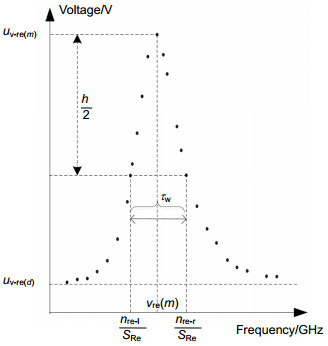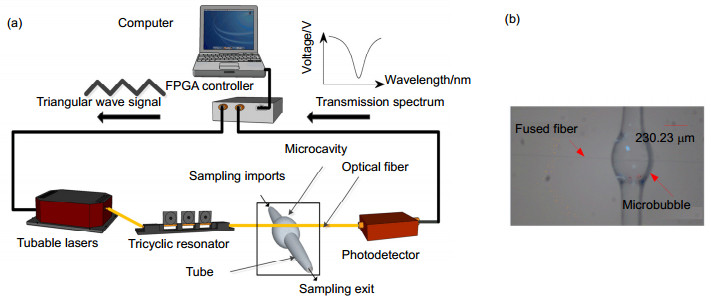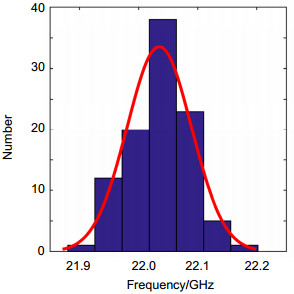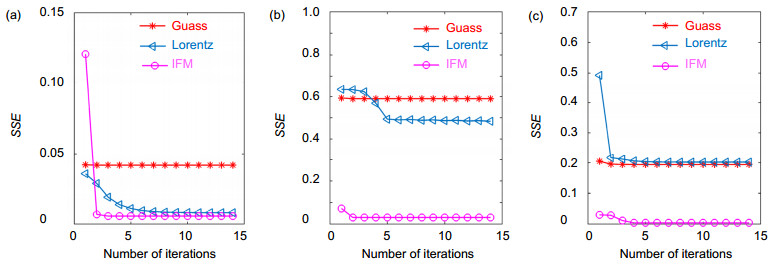Optical microcavity transmission spectrum fitting algorithm based on the implicit function model
-
摘要:
光学微腔品质因子高、灵敏度高,在精密生物传感方面有广阔的应用前景。针对洛伦兹拟合算法不能很好地拟合光学微腔输出端非对称波形和劈裂模式波形的问题,提出了隐函数模型算法。该算法首先建立模板波形,然后经平移、放缩理论实现模板波形操作,利用Levenberg-Marquardt (LM)算法优化参数值,能够实现对称波形、非对称波形和劈裂模式波形数据拟合。通过搭建光学微腔数据采集系统,采用高斯、洛伦兹和隐函数模型算法对不同折射率溶液的实验数据进行拟合。结果表明:隐函数模型算法比前两种算法的MSE低1个数量级,且拟合优度(R2)达到了0.99,拟合效果较好;隐函数模型算法谐振频率误差最小,谐振频率偏移量最大,对应的灵敏度最高,有利于提高光学微腔灵敏度。
 Abstract:
Abstract:The optical microcavity has high Q factors and high sensitivity, and has a good application prospect in high-precision biosensing. In order to deal with the problem that the Lorentz fitting algorithm cannot fit the asymmetric waveform and the splitting mode waveform of the optical microcavity, the implicit function model algorithm is proposed. Firstly, according to the method, the template waveform was established and operated by panning and zooming.Then the parameter values were optimized by the Levenberg-Marquardt (LM) algorithm. Finally, data fitting of symmetrical waveform, asymmetric waveform and splitting mode waveform could be achieved. Through constructing the data acquisition system of optical microcavity, the Gauss, the Lorentz and the implicit function model algorithm were used to fit the experimental data of different refractive index of solutions. The results show that MSE of the implicit function model algorithm is one order of magnitude lower than other two algorithms, and has a coefficient of determination (R2) of 0.99. The resonant frequency error of implicit function model algorithm is the smallest, the resonant frequency of implicit function model algorithm is the largest, and the sensitivity of implicit function model algorithm is the highest. Therefore, the fitting effect of the implicit function model algorithm is better and it can efficiently improve the sensitivity of the optical microcavity.
-
Key words:
- optical microcavity /
- implicit function model /
- LM algorithm /
- data fitting /
- transmission spectrum
-

Abstract: Due to its high quality factor and high sensitivity, the optical microcavity has well promising applications in optical sensing, biomedical, nonlinear optics, environmental monitoring and quantum physics. The principle is that when analyses enter the optical microcavity, the effective refractive index of the solution will change, and the resonant wavelength will be shifted. Therefore, it is very important to find out the variation of resonant wavelength to improve the sensing accuracy of the optical microcavity. A traditional method to do this is using the Lorentz algorithm to fit the transmission spectrum of the optical microcavity. However, the Lorentz fitting algorithm cannot well fit the spectrum when it is an asymmetric waveform or there is a splitting mode waveform within the optical microcavity. In order to deal with the problem, the implicit function model algorithm is proposed in this study. The process of our method can be described as follows. The template waveform was selected and established first, followed by the panning and zooming operations. Then, a traditional method was used to set the initial value of the parameter of objective function, and the parameter values were optimized by the Levenberg-Marquardt (LM) algorithm, which could achieve data fitting results of symmetrical waveform, asymmetric waveform and splitting mode waveform. Note that there was no definite mathematical expression according to the implicit function model algorithm, so different methods were used to obtain the partial derivative of the factor in the Jacobian matrix by means of the template data. In this study, experimental platform, including the optical microcavity, tunable laser source and controller, data acquisition and control system, was established. Different concentrations of solutions of dimethyl sulfoxide, glucose and glycerol were tested as the analyte, and the Gauss, the Lorentz and the implicit function model algorithm were used to fit the experimental data of different transmission spectrums. The results show that MSE of the implicit function model algorithm is one order of magnitude lower than other two algorithms, and the coefficient of determination (R2) is 0.99. The resonant frequency error of implicit function model algorithm is the smallest, the resonant frequency of implicit function model algorithm is the largest, and the sensitivity of implicit function model algorithm is the highest. Therefore, the fitting effect of the implicit function model algorithm is better and it can efficiently improve the sensitivity of the optical microcavity and has a reliable basis on the follow-up to find the spectral resonance center to detect the biological components. The digital implicit function model algorithm will have a wide application prospect in any shape waveform data fitting.
-

-
图 5 三种不同溶液下高斯、洛伦兹和隐函数模型算法SSE值比较图(IFM:隐函数模型). (a) DMSO RI=1.3526. (b)葡萄糖RI=1.3587. (c)甘油RI=1.3511.
Figure 5. Comparison of SSE values for Gaussian, Lorentz and implicit function model in three different solutions(IFM: Implicit function model). (a) DMSO RI=1.3526. (b) Glucose RI=1.3587. (c) Glycerol RI=1.3511.
图 6 高斯、洛伦兹、隐函数模型算法拟合三组溶液所得对比图(ED:实验数据;IFM:隐函数模型). (a) DMSO RI=1.3526. (b)葡萄糖RI=1.3587. (c)甘油RI=1.3511.
Figure 6. Contrast map of three solutions fitted by Gaussian, Lorentz and implicit function model(ED: Experimental data; IFM: Implicit function model). (a) DMSO RI=1.3526. (b) Glucose RI=1.3587. (c) Glycerol RI=1.3511.
表 1 高斯、洛伦兹、隐函数模型拟合算法调谐频率的比较.
Table 1. The comparison of frequency detuning among Gauss, Lorentz and implicit function model algorithm.
Solution Actual frequency detuning/GHz Frequency detuning/GHz Frequency detuning error/GHz IFM Gauss Lorentz IFM Gauss Lorentz DMSO RI=1.3526 -18.72 -18.7196 -18.7192 -18.7181 0.0004 0.0008 0.0019 Glucose RI=1.3587 -13.82 -13.8226 -13.7944 -13.7999 0.0226 0.0056 0.0001 Glycerol RI=1.3511 -17.76 -17.7703 -17.7931 -17.7949 0.0103 0.0331 0.0349 表 2 高斯、洛伦兹和隐函数模型算法拟合程度判断.
Table 2. The fitting degree of Gauss, Lorentz and implicit function model algorithm.
Solution MSE R2 IFM Gauss Lorentz IFM Gauss Lorentz Average 3.37×104 5.3×103 5.38×103 0.998075 0.970083 0.96955 表 3 高斯、洛伦兹、隐函数模型拟合算法灵敏度的比较.
Table 3. The comparison of sensitivity among Gauss, Lorentz and implicit function model algorithm.
Solution RI Frequency detuning/GHz Frequency detuning offset/GHz Sensitivity /nm·RIU-1 IFM Gauss Lorentz IFM Gauss Lorentz IFM Gauss Lorentz DMSO 1.3430 -19.2211 -19.2335 -19.2395 0.6421 0.6087 0.6373 0.31089 0.2947 0.3085 1.3478 -18.5790 -18.6248 -18.6022 Glycerol 1.3600 -13.8210 -13.7969 -13.7908 1.4545 1.4446 1.4382 0.1888 0.1876 0.1867 1.3690 -12.3665 -12.3523 -12.3526 Glucose 1.3495 -17.7715 -17.7726 -17.7555 1.5317 1.5299 1.5125 0.2094 0.2092 0.2068 1.3665 -16.2398 -16.2427 -16.2430 -
[1] Wang Y G, Chen Chengchang, Chiu C H, et al. Lasing in metal-coated GaN nanostripe at room temperature[J]. Applied Physics Letters, 2011, 98(13): 131110. doi: 10.1063/1.3572023
[2] Vollmer F, Arnold S. Whispering-gallery-mode biosensing: label-free detection down to single molecules[J]. Nature Methods, 2008, 5(7): 591–596. doi: 10.1038/nmeth.1221
[3] Chen Chengchang, Shih M H, Yang Yichun, et al. Ultraviolet GaN-based microdisk laser with AlN/AlGaN distributed Bragg reflector[J]. Applied Physics Letters, 2010, 96(15): 151115. doi: 10.1063/1.3399781
[4] 李皓. 新型光学微腔和微腔激光器生物传感效应研究[D]. 上海: 复旦大学, 2011.
http://cdmd.cnki.com.cn/Article/CDMD-10246-1011184277.htm [5] Böttner S, Li Shilong, Jorgensen M R, et al. Vertically aligned rolled-up SiO2 optical microcavities in add-drop configuration[J]. Applied Physics Letters, 2013, 102(25): 251119. doi: 10.1063/1.4812661
[6] Kimble H J. The quantum internet[J]. Nature, 2008, 453(7198): 1023–1030. doi: 10.1038/nature07127
[7] Ren Liqiang, Wu Xiang, Li Ming, et al. Ultrasensitive label-free coupled opt-ofluidic ring laser sensor[J]. Optics Letters, 2012, 37(18): 3873–3875. doi: 10.1364/OL.37.003873
[8] 张兴旺. 高灵敏光微流回音壁模式微腔生化传感器[D]. 上海: 复旦大学, 2014.
http://cdmd.cnki.com.cn/Article/CDMD-10246-1015428822.htm [9] 金虎, 陆云, 白晓淞.基于回音壁模式的球形光学微腔实验研究[J].激光与光电子学进展, 2012, 49(6): 062301. http://kns.cnki.net/KCMS/detail/detail.aspx?filename=jgdj201206023&dbname=CJFD&dbcode=CJFQ
Jin Hu, Lu Yun, Bai Xiaosong. Experimental study of whispering gallery mode-based spherical optical microcavity[J]. Laser & Optoelectronics Progress, 2012, 49(6): 062301. http://kns.cnki.net/KCMS/detail/detail.aspx?filename=jgdj201206023&dbname=CJFD&dbcode=CJFQ
[10] 张有迪, 李嘉琪, 孟钏楠, 等.布里渊散射谱拟合的混合优化算法[J].强激光与粒子束, 2015, 27(9): 091013. http://www.wanfangdata.com.cn/details/detail.do?_type=perio&id=qjgylzs201509014
Zhang Youdi, Li Jiaqi, Meng Chuannan, et al. Hybrid optimization algorithm of brillouin scattering spectra fitting[J]. High Power Laser and Particle Beams, 2015, 27(9): 091013. http://www.wanfangdata.com.cn/details/detail.do?_type=perio&id=qjgylzs201509014
[11] 周鹏, 张文斌, 王军星, 等.基于高斯拟合的光纤型SPR信号的峰值检测算法[J].光谱学与光谱分析, 2016, 36(6): 1949–1953. http://www.cqvip.com/QK/90993X/201606/669126771.html
Zhou Peng, Zhang Wenbin, Wang Junxing, et al. Peak detection algorithm of optical fiber SPR signal based on the Gaussian fitting[J]. Spectroscopy and Spectral Analysis, 2016, 36(6): 1949–1953. http://www.cqvip.com/QK/90993X/201606/669126771.html
[12] 张燕君, 贾伟, 付兴虎, 等.一种基于多准则决策和PSO-LM混合优化算法的多峰Brillouin散射谱的特征提取方法[J].光谱学与光谱分析, 2016, 36(7): 2183–2188. http://www.cnki.com.cn/Article/CJFDTOTAL-GUAN201607040.htm
Zhang Yanjun, Jia Wei, Fu Xinghu, et al. A multi-peak Brillouin scattering spectrum feature extraction method based on mul-ti-criteria decision-making and particle swarm optimiza-tion-levenberg marquardt hybrid optimization algorithm[J]. Spectroscopy and Spectral Analysis, 2016, 36(7): 2183–2188. http://www.cnki.com.cn/Article/CJFDTOTAL-GUAN201607040.htm
[13] Naeli K, Brand O. An iterative curve fitting method for accurate calculation of quality factors in resonators[J]. Review of Scientific Instruments, 2009, 80(4): 045105. doi: 10.1063/1.3115209
[14] 陈瑞强, 闻路红. 脉冲波形的拟合方法: 105044702A[P]. 2015-11-11.
[15] Li Beibei, Xiao Yunfeng, Zou Changling, et al. Experimental observation of Fano resonance in a single whispering-gallery microresonator[J]. Applied Physics Letters, 2011, 98(2): 021116. doi: 10.1063/1.3541884
[16] Wu Xiaowei, Zou Changling, Cui Jinming, et al. Modal coupling strength in a fibre taper coupled silica microsphere[J]. Journal of Physics B Atomic Molecular & Optical Physics, 2009, 42(8): 085401. http://iopscience.iop.org/article/10.1088/0953-4075/42/8/085401/pdf
[17] Dong Chunhua, Zou Changling, Xiao Yunfeng, et al. Modified transmission spectrum induced by two-mode interference in a single silica microsphere[J]. Journal of Physics B: Atomic, Mo-lecular and Optical Physics, 2009, 42(21): 215401. doi: 10.1088/0953-4075/42/21/215401
[18] Luo Yunhan, Chen Xiaolong, Xu Mengyun, et al. Optofluidic glucose detection by capillary-based ring resonators[J]. Optics & Laser Technology, 2014, 56: 12–14. https://www.sciencedirect.com/science/article/pii/S0030399213002600
[19] Lourakis M I A. A Brief Description of the Levenberg-Marquardt Algorithm Implemened by levmar[J]. Foundation of Research & Technology, 2005: 1–6. http://users.ics.forth.gr/~lourakis/levmar/levmar.pdf
[20] Tang Ting, Wu Xiang, Liu Liying, et al. Packaged optofluidic microbubble resonators for optical sensing[J]. Applied Optics, 2016, 55(2): 395–399. doi: 10.1364/AO.55.000395
-


 E-mail Alert
E-mail Alert RSS
RSS
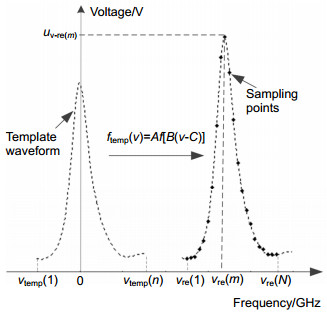
 下载:
下载:
